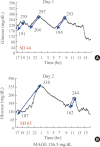Clinical Implications of Glucose Variability: Chronic Complications of Diabetes
- PMID: 26194076
- PMCID: PMC4508260
- DOI: 10.3803/EnM.2015.30.2.167
Clinical Implications of Glucose Variability: Chronic Complications of Diabetes
Abstract
Glucose variability has been identified as a potential risk factor for diabetic complications; oxidative stress is widely regarded as the mechanism by which glycemic variability induces diabetic complications. However, there remains no generally accepted gold standard for assessing glucose variability. Representative indices for measuring intraday variability include calculation of the standard deviation along with the mean amplitude of glycemic excursions (MAGE). MAGE is used to measure major intraday excursions and is easily measured using continuous glucose monitoring systems. Despite a lack of randomized controlled trials, recent clinical data suggest that long-term glycemic variability, as determined by variability in hemoglobin A1c, may contribute to the development of microvascular complications. Intraday glycemic variability is also suggested to accelerate coronary artery disease in high-risk patients.
Keywords: Glucose variability; Macrovascular complications; Microvascular complications.
Conflict of interest statement
Figures



References
-
- Krinsley JS. Glycemic variability: a strong independent predictor of mortality in critically ill patients. Crit Care Med. 2008;36:3008–3013. - PubMed
-
- Egi M, Bellomo R, Stachowski E, French CJ, Hart G. Variability of blood glucose concentration and short-term mortality in critically ill patients. Anesthesiology. 2006;105:244–252. - PubMed
-
- Siegelaar SE, Holleman F, Hoekstra JB, DeVries JH. Glucose variability; does it matter? Endocr Rev. 2010;31:171–182. - PubMed
Publication types
LinkOut - more resources
Full Text Sources
Other Literature Sources

